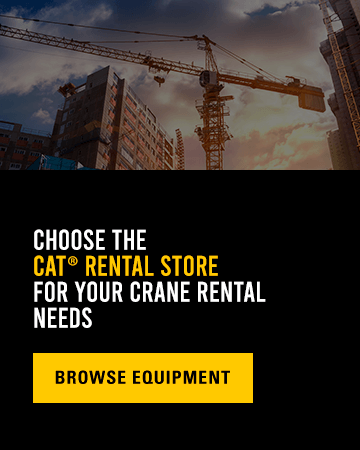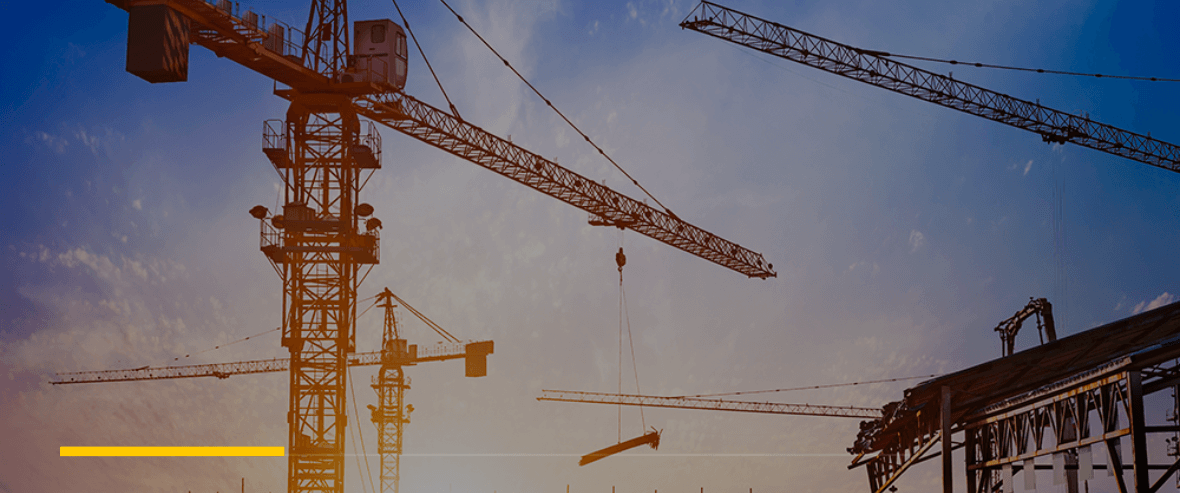
Renting Cranes: The Ultimate Guide
A crane is an essential piece of equipment for many construction work sites. Many companies choose to rent cranes, as rentals give them greater flexibility and allow them to use a crane only for the required time. As companies look to rent a crane for their next project, it's a good idea to know about some of the top practices of experienced renters.
Before you rent, learn more about the primary types of cranes, their uses and some of the job requirements you may want to consider as you search for a crane. Additionally, you may want to find out more about some of the top tips for selecting the best crane possible and information on how to use it properly. Our ultimate guide to renting cranes explains everything you need to know.
Jump to a section:
Types of Cranes
While you search for a crane, you may want to know the primary types of cranes used in construction first. While many different types of cranes are available, you can break them down into two main categories: mobile cranes and static cranes. Learning about the differences between the two can help you know what type of crane to rent.
A static crane is a semi-permanent or permanent structure placed on a building or the ground. This type of crane then moves and lifts loads through fixed paths. Often, static cranes aren't offered as rentals since they're used for a long time.
In contrast, a mobile crane has wheels or treads that make it easy to transport it from one location to another. Once placed, the crane can be used for handling loads and other applications. Unlike fixed cranes with fixed paths, mobile cranes can pick up loads and transport them to varying locations. Some mobile cranes will require counterweights and outriggers for proper use.
Many mobile cranes are pulled behind other vehicles or loaded onto a truck to make it to a work site. Once they arrive, an operator can drive the crane around the work site to complete various jobs. Other mobile cranes are built directly onto a truck that can drive on the highway to job sites without being pulled or loaded onto another vehicle, allowing for quick deployment to multiple job sites.
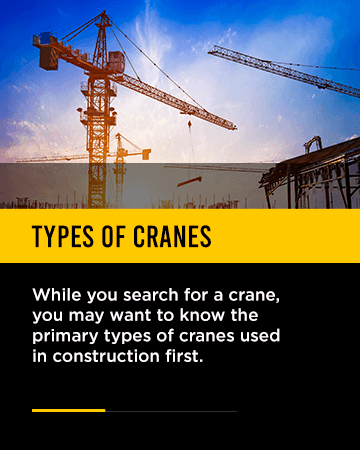
Mobile Crane Uses
Cranes are primarily used in the construction sector to conduct several types of lifting tasks. A mobile crane uses a series of advanced pulleys and cables to lift incredibly heavy loads people would never have the strength to lift on their own. They can be used for short-term pick-up tasks or larger-scale, long-term operations.
In the construction industry, operators often use mobile cranes to quickly move equipment and materials around a work site. Additionally, rental cranes regularly lift heavy building materials to crew members working at a high location. Since the crane can easily lift materials from the ground to the top of buildings and other elevated locations, staff don't have to lug equipment up flights of stairs or invest in other types of lifting equipment. You'll often see workers using cranes to assist with roofing jobs to improve efficiency.
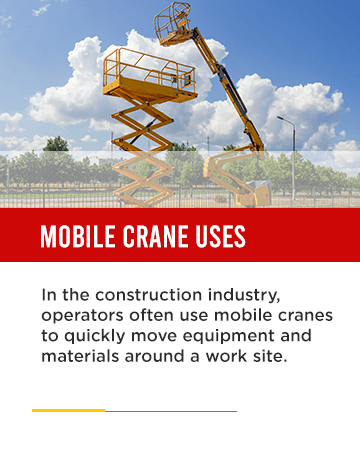
Consider Your Job Requirements When Selecting a Crane
While you look for the perfect crane for your needs, you need to ensure the crane fits your project's requirements. You'll want to avoid selecting a crane that can't handle your work site's terrain or doesn't have the height needed to lift materials high enough. By evaluating your work site before you rent, you can ensure you get a crane fitting all of your requirements.
Consider these job requirements before renting a crane:
- Size of job site: Before you rent a crane, one of the first job requirements you should consider is the size of the site where you're going to be working. A site with lots of space can facilitate a larger crane and likely requires one that you can drive quickly around the job site. A smaller work site usually needs a smaller crane that can fit in tight spaces.
- The terrain of the site: Mobile cranes come with varying types of wheels appropriate for different terrains. Companies whose work sites have challenging terrain to navigate, for instance, may want a rough-terrain crane featuring heavy-duty tires. For less challenging terrains, a crane with standard wheels may be sufficient.
- Weight and size of materials: Before you rent a crane, it's a good idea to check on the size and weight of the materials you plan to lift with your crane. You don't want to rent a crane without the space and load capacity to pick up certain materials. Larger cranes can also help workers lift and transport materials faster.
- Height of lifts: Another factor to consider about your job site is how high you'll need to lift materials and tools. The taller the building you're working on, the higher the lift height you'll need. Evaluating the lift height required by the work you'll be doing ensures you rent a crane that can handle all of your potential applications of it.
- Distance and radius required: As with the height of the crane, you may need your crane to move materials over certain distances. Check the manufacturer's specs to see if the crane can cover the needed distance and has the radius to swing the crane to the required locations.
- Crane storage opportunities: If there are times when the crane isn't going to be used on the work site, you may need to store it. Ensure your job site can keep the crane secured and stored safely. If your work site doesn't have a lot of space, you may want to select a smaller crane that's easier to store.
- Safety hazards: Sometimes, work sites have safety hazards, like power lines, cranes will have to navigate around or under. A crane that doesn't have the mobility to go around a power line or other hazards could damage the project or the crane itself. Additionally, a crane may need to go under a power line, so it's important to select a crane that's not too large and can lower its boom low enough to fit under an overhead hazard.
- Project timeline: It's also important to evaluate how long your project will require the crane to be on the job site. Knowing this information can ensure you set up a contract with the rental company that covers the amount of time you'll need the crane.
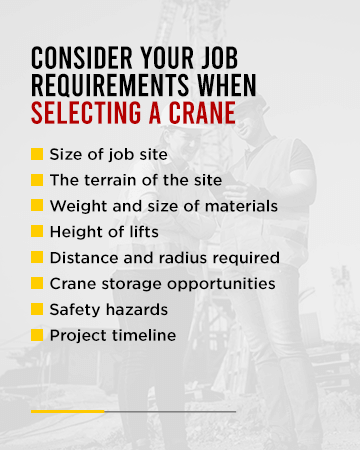
Tips for Choosing a Crane
There are a few tips to be aware of to help you find the right crane for your next project. Renting the right crane often comes down to evaluating your project's requirements, setting a realistic timeline, verifying a transportation method and receiving the right permits.
1. Keep Your Project's Requirements in Mind
As you look for a rental, keep all of the project's requirements in mind. Refer to your job site evaluation while you browse a rental company's offerings or speak to a representative. Choosing a crane that fits your job site's requirements ensures you can complete your project efficiently and on time.
To pick the right crane, familiarize yourself with the specs of cranes. These are some of the primary specs you'll want to check before renting:
- Lift capacity: The crane's lift capacity is essential to inspect before you select a rental. The lift capacity refers to the maximum amount of weight the crane can handle. You'll want to select a crane with a lift capacity that can safely lift the heaviest load your project requires. By ensuring the crane you select has the appropriate lift capacity, you avoid damaging the crane and keep your work site running at peak efficiency.
- Maximum vertical reach: The maximum vertical reach of a crane is crucial as well. This spec refers to the top height a crane can reach, with cranes offering several height selections. Compare the maximum vertical reach of a crane to the maximum height you'll need to reach with the crane to complete your project. This comparison will help you select a crane that can lift materials and tools high enough throughout your whole project.
- Vehicle weight: The crane's weight will often correlate with the lift capacity and the maximum vertical reach of the crane. Sometimes, companies will want lighter cranes so they don't make as much of an impression on the ground.
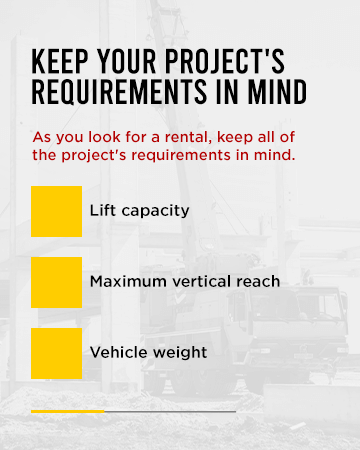
2. Find an Experienced Rigger
Cranes need an experienced rigger to ensure the crane is set up properly and ready to be used. A rigger will fasten the cables, chains and straps to ensure the crane functions safely and performs up to your standards. The rigger will also execute the crane's lift and handle other duties depending on the job's requirements. An experienced rigger can also help you determine how many crew members you need for your projects.
You may already have a rigger on your staff, but if you don't, it's crucial you find one early on to discuss the project's requirements. They can give you more information on the type of crane you'll need and how different cranes will perform on the work site.
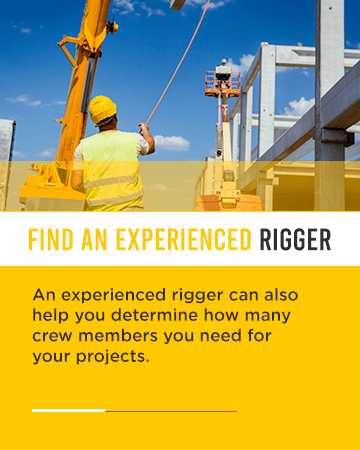
3. Book Your Rental in Advance
When you rent a crane, it's important you book it in advance to ensure the crane you want is available. Companies that wait to rent a crane until a day or two before they need it can slow down their project, as the crane they need may not be available on short notice. Since the top rental companies usually have a high demand for their cranes, they may have them booked for weeks, sometimes even months, in advance.
Well before your project begins, reach out to the rental company to discuss their availabilities and options. By reaching out well before a project, you should have more options.
4. Verify the Transportation Method
Some companies will transport the crane to your work site, while others will require you to pick it up yourself. As a result, it's essential to verify with the rental company how the crane will be transported. By verifying the crane's transportation method, a company can get the crane to their project on the day they need it or plan for proper transportation if they have to handle it themselves.
A rental company offering transportation can be a big plus, as you won't have to worry about getting a vehicle to haul the crane to the work site or risk mishandling it during transportation. If the rental company handles transportation, you'll simply need to tell them when and where you need the crane, and they should get it to you on time, helping you meet your project's deadlines.
Tightly coordinating transportation also helps you coordinate other important tasks. Since your crew will know exactly when the crane will arrive, they can be ready to start work immediately once it arrives. It also helps your crew members have the additional rigging, materials and equipment that the crane needs ready by the right time, so you can start using the crane without a hitch.
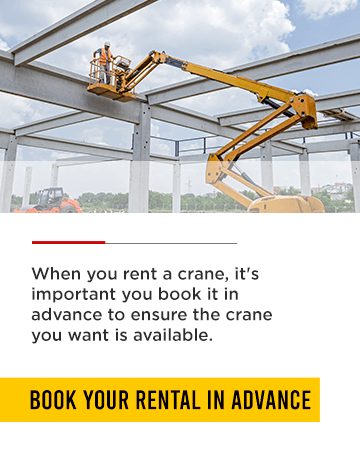
5. Get the Appropriate Permits
Before you rent a crane, look into your local laws about using cranes to see if you need any special permits. By receiving the proper permits before the crane arrives, you can use the crane immediately. If you're unsure of your local permits and laws, calling your local permitting office can be very helpful, allowing you to avoid fines and shutdowns.
6. Rent the Crane for a Realistic Amount of Time
When you speak to the rental company, have a clear idea of your project timeline. By honestly evaluating how long your project will take, you're more likely not to rent a crane for too little or too much time. If you rent it for more time than you need, you can pay too much in rental costs. If you rent it for too little time, you may have to return the crane before you're doing using it.
While renting a crane for too long can add to your costs, it's even more important to make sure you're not renting it for too little time. Properly estimate your project's timelines to avoid major delays and keep your crane on the site as long as you need it. Renting it for an appropriate amount of time also keeps your crews safer, as crews won't try to speed through projects to get their work done before the crane has to be returned.
As you go about renting, overestimating how long you'll need the crane is usually the safer choice. Overestimating gives your crew breathing room while they work. Sometimes, minor mistakes and unforeseen conditions can arise that slow down your project. Overestimating the time you need to rent the crane will give your crew plenty of time to deal with any challenging conditions appropriately without worrying about having to return the crane before they're done using it.
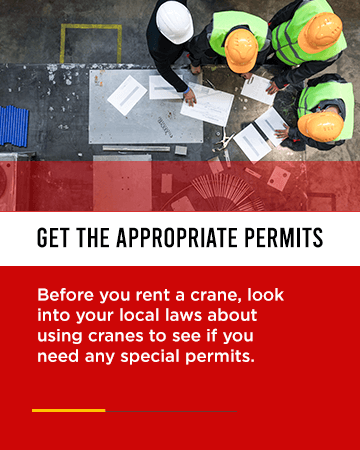
7. Prepare Your Site for the Crane
Before the crane arrives, it's a good idea to prepare your site for it. Start by ensuring the truck bringing the crane has enough space to enter the work site safely and reach the area where the crane needs to be dropped off. You may also want to have any extra equipment or tools used with the crane ready to use and near the crane.
By creating a clear path for your crane's drop off and having materials ready, you can avoid inefficiencies and delays on the day the crane arrives. You'll be ready to start working immediately and keep your project on track to hit deadlines.
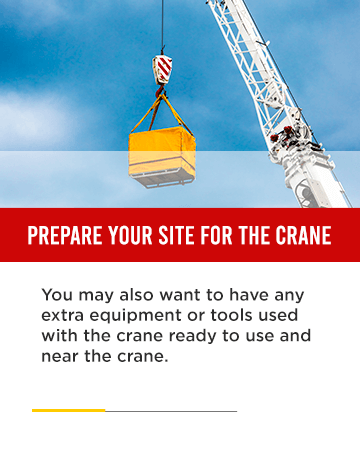
How to Use Cranes Properly
Once you've rented a crane, using it properly can help you keep your work site safe and your project running at an efficient pace. Here are some of the best practices for using a crane correctly:
- Ensure operators are licensed: Operators should be properly licensed before they use a crane. If a crane operator isn't certified, your company could run into legal problems. An unlicensed operator may also not know how to use the crane properly, leading to injuries and mistakes.
- Wear the right attire: Operators and those working around a crane should also have the right clothing. Hardhats, eye protection, gloves, protective footwear, ear protection and reflective vests are all usually required when working with a crane.
- Conduct a preinspection: Before the crane begins operation, inspect the load, work area and equipment. Check the equipment to ensure everything is in proper working order. Additionally, check the work area for a level surface and any potential hazards. Finally, safe working loads are important, as you don't want to overload the crane, which could cause it to break.
- Cut down on distractions: Operators and those working around the crane need to be alert. Cellphones are a major source of distraction and should be turned off. If a supervisor notices a potential distraction, they should attempt to reduce it before operators use the crane.
- Prepare the crane's load: Before a crane lifts a load, crew members should take the time to balance and secure the load. It's also crucial to check the crane's hook, seeing if it looks worn down or needs replacement. Additionally, crew members shouldn't use a wire rope or load change as a sling.
- Stay safe during the lift: When the load is suspended in the air, crew members should keep an eye on it and never leave it unattended. Crew members also need to know never to walk under the load, and operators should never swing the load over other people. A safety-conscious operator will also pay attention to where the load is going. Additionally, it's important never to pull a load and only push it.
- Put safety first after a lift: Once the load reaches its destination, crew members need to secure it, taking the proper steps to remove the load safely. Additionally, if you're done using the crane, keep the stabilizers, attachments and winches stored in a safe location.
- Stop if something seems wrong: If at any point of using the crane you see something that looks wrong, stop using it immediately. Have a knowledgeable supervisor or operator evaluate what could be wrong and fix it before operating the crane again. When working with such heavy-duty equipment, caution should be the number one rule.
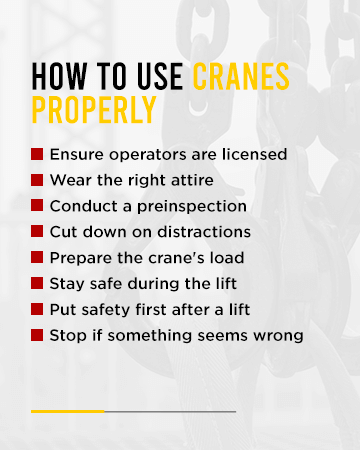
Choose The Cat® Rental Store for Your Crane Rental Needs
Companies all around the world trust The Cat® Rental Store for their equipment rental needs. If you want high-quality rentals for your projects with a crane, we can help. We carry a wide selection of cranes, making it easy for you to find one meeting your unique project requirements. With more than 1,300 locations globally and an extensive inventory of equipment, we can help you with almost any project you might have.
Browse our selection of crane and crane truck rentals to find the perfect fit for your job site. If you have any questions, find your local dealer to speak to a representative.
Find The Cat Rental Store Near You